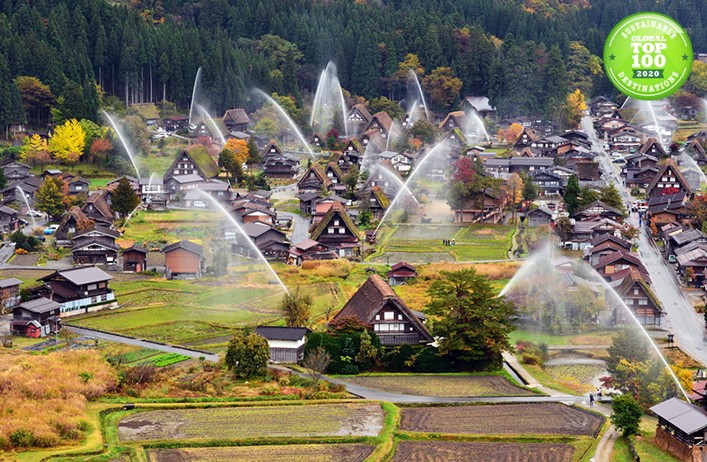Gifu’s regions have been selected for the second consecutive year to the Top 100 list for its excellent Good Practice Stories and have shown to be compliant with the basics of sustainability performance by Green Destinations*1, an international certification organization for sustainable tourism. Gifu Prefecture has always been famous for its abundant nature and world-class traditions and culture. The selection by Green Destinations of Gifu’s Shirakawa Village and Nagara River Basin in 2020 and 2021, respectively, from among many candidate sites, is proof of the world’s recognition that the essence of sustainability is home in Gifu.
In the spirit of YUI
Shirakawa Village, which was registered as part of a UNESCO World Heritage Site*2 in 1995, is famous for its hamlet of gassho-zukuri traditional thatched-roof houses. A custom of mutual support, called yui, has been handed down in this village since olden times.
The villagers help each other protect the traditional houses and preserve the town’s historic landscape by collectively fighting fires and re-thatching the roofs. By experiencing local cuisine around an irori sunken hearth when you stay in one of these houses where villagers still live now, you can catch a glimpse of traditional life with yui passed down through generations and let this relaxing space far away from the hustle and bustle of any cities embrace you. That truly is a “YUI Experience”.
The charm of SEIRYU
The Nagara River is considered one of Japan’s three seiryu, or clearest rivers, boasting an abundance of water and excellent water quality despite flowing through urban areas. Ayu sweet-fish, a symbol of clear streams, inhabits the river’s basin, and ukai, traditional ayu fishing using cormorants, has been practiced in Gifu city for 1,300-years. In 2015, the Nagara River’s upper and middle basins were designated as a GIAHS*3, thereby recognizing local efforts to protect the crystal-clear waters of the river while still utilizing it, for the benefit of future generations. This co-existence between villages (sato) and the river (kawa or gawa) is reflected in the GIAHS designation title [Ayu in the clear Nagara River: the satogawa connection of people and ayu].
Globally important and traditional agriculture, forestry, and fisheries systems in regions that are recognized by the Food and Agriculcure Organization of the United Nations (FAO). Various traditions, cultures, and artisanal techniques that make the most of the blessings of pristine water are preserved here and are passed down from generation to generation.
For example, Seki hamono, knives, formerly swords, produced in Seki, which is said to be the world’s third-largest traditional blade smithing area after Solingen in Germany and Sheffield in England; or Hon Mino washi, authentic Japanese paper handcrafted in Mino which has been used for the restoration of oriental paintings in the British Museum and the Louvre as well as for the victory diplomas for the winners of the 2020 Tokyo Olympic and Paralympic Games; and the traditional Gujo bon odori, an annual dance festival in Gujo that is part of Buddhist celebration to commemorate and honor ancestors, which boasts a history of over 400 years. Travel to this region where you can feel the sustainable cycles of the local people who have chosen to live with the river in harmony rather than fighting it.
Gaze at the beautiful crystal-clear water of the Nagara River and let your “SEIRYU Experience” begin.
Here in the abundance of nature in Gifu Prefecture, the traditions, culture and craftsmanship inherited from our ancestors live on in our daily lives, thereby connecting the good old times of Japan with the present day. The soothing way of sustainable living in Gifu has been enchanting people through the ages, and that is all you need in these stressful times.
Come here for a relaxing retreat and experience Gifu, “Timeless Japan, Naturally an adventure.”
Click here for a Gifu Prefecture video.

